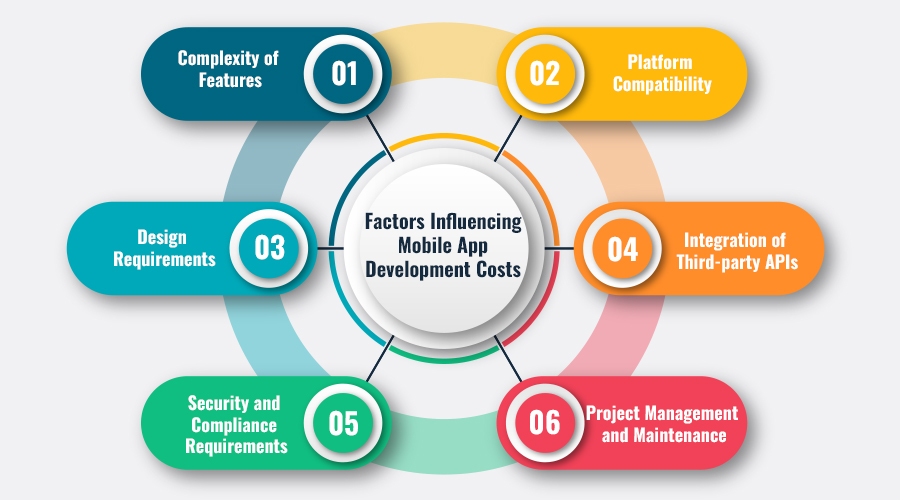The cost of making a mobile app for a new business in 2025 is key for entrepreneurs and startups. The world of mobile app development keeps changing. This is due to new tech, what people want, and cool features.
Knowing what will affect app development costs in 2025 is vital. It helps new businesses get ready to join the mobile app market.
Table of Contents
Key Takeaways
- The cost of developing a mobile app for a new business idea in 2025 will be affected by various factors, including market trends, technological advancements, and the complexity of the app features.
- Businesses will need to consider the different types of mobile apps, such as native, cross-platform, and hybrid apps, and their respective cost implications.
- Investing in cutting-edge technologies like AI and machine learning can significantly impact the development budget, but may also provide long-term benefits.
- Efficient resource allocation, technology stack selection, and cost-saving strategies can help new businesses manage the development costs without compromising on quality.
- Understanding regional cost variations and ensuring compliance with industry-specific regulations will also be crucial in budgeting for mobile app development in 2025.
Understanding the Mobile App Development Landscape in 2025
The mobile app world is set for big changes by 2025. Experts say we’ll see new trends that change how apps are made. These changes include AI in app development and new mobile tech.
Current Market Trends and Projections
The app market is growing fast. It’s expected to hit over $1 trillion by 2025. This growth comes from more people using mobiles for shopping, fun, work, and talking to friends.
Key Technology Shifts Affecting Development Costs
New tech like 5G, cloud computing, and IoT will change app costs. These advancements mean faster data, better device connections, and more app power. This will affect how much apps cost to make.
Impact of AI and Machine Learning on App Development
AI and machine learning will change the app world. They’ll make app making faster, better, and cheaper. This means apps will work better and cost less to make.
“The mobile app market is expected to continue its rapid growth, with estimates indicating a market size of over $1 trillion by 2025.”
Keeping up with app trends helps businesses plan better. They can use their money wisely to take advantage of 2025’s chances.
Factors Influencing Mobile App Development Costs
When planning a mobile app project, knowing the app cost factors and development pricing variables is key. These elements greatly affect your app budget considerations. They play a big role in your project’s success.
The complexity of your app is a major cost driver. More features and integrations mean higher costs. Also, choosing iOS, Android, or a cross-platform solution impacts pricing due to different tools and frameworks.
The design of your app, including UI, UX, and visuals, also matters. Complex designs and custom graphics need more time and expertise. This leads to higher expenses.
The backend infrastructure is another big factor. It includes server-side components, data storage, and APIs. These can raise the budget, especially with third-party services or advanced features like real-time communication or machine learning.
- App complexity: The more features and functionalities, the higher the development costs.
- Platform choice: iOS, Android, or cross-platform development can impact pricing.
- Design requirements: Sophisticated UI/UX and custom visuals increase costs.
- Backend infrastructure: Robust server-side components and integrations add to the budget.
“Understanding the factors that influence mobile app development costs is essential for creating an accurate budget and ensuring the success of your project.”
By understanding these app cost factors and development pricing variables, you can make a detailed app budget considerations. This ensures your mobile app meets your business goals and launches successfully.
Types of Mobile Apps and Their Cost Implications
When planning a mobile app for your business, knowing the different types and costs is key. The world of mobile app development has grown a lot. Now, there are many options for various needs and budgets.
Native Apps vs. Cross-Platform Development
Native apps are made for one platform, like iOS or Android. They use specific tools and languages. Native apps perform well and feel natural to use, but they cost more because you need a version for each platform.
Cross-platform development, like React Native or Flutter, lets you make one app for many platforms. This can save money, making it great for businesses with tight budgets.
Hybrid Apps and Progressive Web Apps
Hybrid apps mix native and web tech. They use HTML, CSS, and JavaScript but can use device features too. They’re cheaper than native apps but still offer a good experience.
Progressive web apps (PWAs) use web tech to feel like apps in your browser. They’re the cheapest to make. You don’t need to make separate apps for each platform.
Cost Comparison Between Different App Types
| App Type | Development Cost | User Experience | Performance |
|---|---|---|---|
| Native Apps | Higher | Excellent | Excellent |
| Cross-Platform Apps | Moderate | Good | Good |
| Hybrid Apps | Lower | Good | Moderate |
| Progressive Web Apps | Lowest | Good | Good |
Choosing the right app type depends on your business needs, audience, and budget. It’s important to weigh the costs, user experience, and performance. This will help you make the best choice for your app project.
Essential Features and Their Impact on Development Budget
Choosing features for a mobile app can greatly affect costs. Knowing which features are key and how much they cost is vital. This helps in planning the budget and deciding what’s most important.
Core Functionality and User Experience
The basic parts of an app, like signing up, managing content, and navigating, are its backbone. These are usually the cheapest to make because they use proven methods. But, making the app easy to use still takes a lot of work.
Advanced Features and their Costs
Modern apps also have extra features to keep users interested. These might include buying things in the app, getting updates in real time, sending notifications, and working with other services. These features are great but can be more expensive because they’re more complex.
Prioritizing Features for Cost-Effective Development
- Find out the must-have features that are key for the app’s main purpose and how users will interact with it.
- Put features in order based on how they’ll affect user interest and making money.
- Look at how hard each feature is to make and what it will cost. This helps make smart choices.
- Think about adding features in stages. Start with the basics, then add more advanced stuff later.
By picking and arranging features wisely, companies can manage their app development budget better. This way, they can make their mobile app without breaking the bank.
“Successful app development is not about packing in every possible feature, but rather focusing on the most valuable and user-centric functionalities.”
Cost of developing a mobile app for a new business idea in 2025
As we approach 2025, it’s key for entrepreneurs and businesses to know the costs of launching mobile apps. The price can change a lot based on several things. These include the app’s basic needs, advanced features, and ongoing upkeep.
Basic App Development Costs
The core of any app is its basic development. This includes design, coding, and testing. In 2025, the cost for this can be between $20,000 and $50,000. This depends on the app’s complexity, the platforms it’s for, and the team’s skills.
Advanced Feature Integration Expenses
Businesses often want to add special features to their apps. These can make the app better for users and more useful. Adding these features can cost between $10,000 and $100,000. This depends on how complex they are and how many are added.
Maintenance and Update Costs
Keeping an app running smoothly is an ongoing task. It includes fixing bugs, updating security, and adding new features. In 2025, the yearly cost for this can be between $5,000 and $20,000. This depends on the app’s complexity and how often it needs updates.
| Cost Category | Estimated Range (2025) |
|---|---|
| Basic App Development | $20,000 – $50,000 |
| Advanced Feature Integration | $10,000 – $100,000 |
| Maintenance and Updates | $5,000 – $20,000 (annual) |
Knowing the different costs helps businesses plan and budget for their app projects in 2025. This ensures a smooth and successful launch.
Choosing the Right Development Team Structure
Building a mobile app for your business in 2025 depends on your team’s structure. You have three main choices: in-house teams, outsourcing, or a mix of both.
An in-house app development team gives you control and customization. But, it costs a lot to hire and keep skilled development talent. Outsourcing can offer more affordable access to app development team members. Yet, it might make communication and project management harder.
The hybrid model blends the best of both worlds. It lets you use in-house experts for key tasks and outsource others. This way, you can save money and still control your app’s development.
| Approach | Pros | Cons |
|---|---|---|
| In-house Team |
|
|
| Outsourcing |
|
|
| Hybrid Model |
|
|
Choosing the right team structure for your app project is crucial. You need to balance cost, control, and access to development talent. Knowing the pros and cons of each option helps you make a choice that fits your business goals and budget.
Timeline Considerations and Cost Dependencies
The time it takes to make a mobile app is key to its cost. Knowing the different stages and how long they take helps businesses budget better.
Development Phases and Duration
The app-making process has several stages, each with its own tasks and time frames:
- Discovery and Planning: 2-4 weeks
- Design and Prototyping: 4-8 weeks
- Development and Testing: 8-16 weeks
- Deployment and Launch: 2-4 weeks
The time for each stage can change based on the app’s complexity, needed features, and team size.
Cost Variations Based on Project Speed
Companies often want to speed up app development to hit the market sooner. But, this can increase costs. Rushing might need more people or special skills, raising costs.
Going slower can help keep costs down. This might mean focusing on key features, using efficient tech, or outsourcing.
| Project Speed | Estimated Timeline | Potential Cost Impact |
|---|---|---|
| Accelerated | 6-8 weeks | Higher development costs |
| Standard | 12-16 weeks | Balanced development costs |
| Gradual | 20-24 weeks | Lower development costs |
Understanding how app development time, project length, and cost are linked helps businesses make smart choices. These choices should fit their budget and goals.

Hidden Costs and Additional Expenses to Consider
When planning a mobile app project, remember to budget for more than just development costs. Many businesses forget about hidden app costs and unexpected expenses. These can greatly affect your total investment. Knowing these extra factors helps you prepare and manage your resources for a successful app launch.
One hidden cost is the cost of adding third-party services and APIs to your app. These features improve your app but can increase costs. You’ll also need to budget for updates and maintenance of these integrations.
Another often-overlooked expense is app marketing and user acquisition. A good marketing strategy is key to getting users. This includes costs for ads, content creation, and working with influencers.
- Third-party service and API integration costs
- Licensing and subscription fees for third-party tools
- App marketing and user acquisition expenses
- Ongoing maintenance and update costs
- Legal and compliance requirements (e.g., data privacy, regional regulations)
Also, think about the costs of keeping your app updated over time. As technology changes, you’ll need to update your app regularly. This ensures it stays useful and competitive.
By planning for these hidden costs and extra expenses, you can get a clearer picture of what it takes to launch your app in 2025.
“Overlooking hidden costs is one of the most common mistakes businesses make when developing a mobile app. Careful planning and budgeting for these expenses can make a significant difference in the long-term success of your app.”
Cost-Saving Strategies Without Compromising Quality
Businesses often face the challenge of making mobile apps without spending too much. Luckily, there are ways to save money without losing quality. Let’s look at some effective methods to cut costs while keeping your app top-notch.
Efficient Resource Allocation
One key to saving money is efficient resource allocation. This means matching tasks with the right people and resources. By doing this, you can avoid wasting money and still make a great app.
- Leverage in-house expertise: Use team members with the right skills for specific tasks.
- Outsource strategically: Choose freelancers or agencies for certain tasks to save money.
- Implement agile methodologies: Use agile methods for faster, more flexible development.
Technology Stack Selection
The technology you choose affects your app’s cost. Picking the right tools can make development more efficient and cheaper in the long run.
- Evaluate cross-platform development frameworks: Look into frameworks like React Native or Flutter for building apps for many platforms at once.
- Utilize open-source technologies: Use open-source tools and libraries for cost savings.
- Adopt no-code/low-code platforms: Try no-code or low-code platforms for easier development and less coding.
By using these strategies, you can make a mobile app that’s both affordable and high-quality. This way, you’ll get a good return on your investment.
Regional Cost Variations in App Development
Developing a mobile app for a new business idea can cost a lot, depending on where you do the work. App development rates, outsourcing costs, and regional pricing all play a part in your budget.
One big reason for cost differences is labor rates around the world. For example, app developers in North America or Western Europe charge more than those in Eastern Europe, Asia, or Latin America. Companies looking to outsource their app development might save a lot by choosing these regions.
- North America and Western Europe: Higher global app development rates
- Eastern Europe, Asia, Latin America: Lower outsourcing costs
- Regions with lower labor costs: More attractive regional pricing for app development
But, remember, saving money by outsourcing might not always be worth it. You might face communication issues, cultural barriers, and need better project management. It’s key to weigh the cost against the quality when picking your app development team.
“Navigating the diverse regional pricing landscape is crucial for businesses looking to develop a successful mobile app in 2025.”
Investment in Security and Compliance
In today’s fast-changing world of mobile apps, keeping data safe and following rules is key. As worries about data and privacy grow, app makers must focus on strong data protection investment. This is to keep users’ personal info safe.
Data Protection Measures
It’s vital to have good data protection to avoid compliance expenses from data breaches. App developers need to use the latest security tools. This includes encryption, access controls, and safe data storage to keep data safe from hackers.
- Encryption of user data, including personal and financial information
- Secure authentication methods, such as biometrics or two-factor authentication
- Comprehensive access controls to limit user and employee access to sensitive data
- Regularly scheduled data backups and disaster recovery planning
Industry-Specific Regulations
Apps in different fields must follow specific rules. App developers need to know the latest industry-specific regulations. This helps avoid big fines and legal problems.
| Industry | Relevant Regulations |
|---|---|
| Healthcare | HIPAA (Health Insurance Portability and Accountability Act) |
| Finance | PCI DSS (Payment Card Industry Data Security Standard) |
| Education | FERPA (Family Educational Rights and Privacy Act) |
By focusing on app security costs and following rules, app developers can keep users’ data safe. This also helps avoid legal and financial troubles. It makes their apps more valuable and trustworthy.
Post-Launch Expenses and Ongoing Maintenance
Developing a mobile app is just the start. Once it’s live, you’ll face new expenses for its success. App maintenance costs, update expenses, and long-term app investment are key for any business.
Server maintenance is a big ongoing cost. Your app needs a reliable hosting solution for user traffic and data. This cost grows as your user base increases. Regular updates and bug fixes are also vital for a smooth app experience.
Adding new features is another big expense. As user needs change and market trends shift, you’ll need to update your app. This might include new functionalities, tech integrations, or UI improvements.
| Expense Category | Average Annual Cost |
|---|---|
| Server Maintenance | $5,000 – $25,000 |
| Software Updates and Bug Fixes | $10,000 – $50,000 |
| Feature Enhancements | $15,000 – $100,000 |
It’s important to budget for these app maintenance costs, update expenses, and long-term app investment. This ensures your app’s continued success. By planning for these costs, you can make smart decisions and use resources wisely.
Return on Investment Calculations
As a business owner, it’s key to know the return on investment (ROI) of a mobile app. You need to look at development costs, expected revenue, and how to get users. This helps figure out if the app is a good investment.
To check if the app can make money, start with the total cost. This includes the initial development, any extra features, and ongoing updates. Knowing these costs helps you guess how much money the app might make.
When thinking about the investment return, think about who will use the app, how it will make money, and ads. Look at how you plan to get and keep users. By balancing costs and expected earnings, you can estimate the app’s ROI.
The app ROI is not just a one-time thing. It’s something you should keep an eye on as your app grows and the market changes. By making smart choices based on data, you can make your app profitable and successful in the long run.
“Investing in a mobile app is a strategic decision that requires careful financial planning and analysis. By understanding the ROI potential, businesses can make informed choices that align with their overall growth objectives.”
Conclusion
The cost of making a mobile app for a new business idea in 2025 is complex. It involves understanding the changing app development world and what affects costs. Businesses need to carefully consider these factors to launch their app successfully and affordably.
Keeping up with market trends, tech advancements, and new tech like AI is key. This helps businesses make smart choices and manage their app development budgets well. Planning the app’s type, features, and the team’s structure can also reduce costs and ensure a good return on investment.
The mobile app market is growing and changing fast. Businesses must stay alert in their app development plans for 2025. With thorough research, strategic planning, and cost-saving strategies, entrepreneurs can make their mobile app projects successful. They can also take advantage of the opportunities in the mobile app world.


















